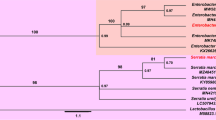Abstract
The polyphagous gypsy moth (Lymantria dispar) is able to feed on about 400 different woody plant species. In general, oak species are preferred – on the other hand some other groups of plants are avoided on account of the presence of toxic substances. These unfavoured hosts are, for example, most of the Papilionaceae, like locust (Robinia pseudoacacia). We compared survival rate and development of two populations of different origin with long-term habituation to oak and locust, respectively. Larvae from the population habituated to oak proved unable to develop on locust food. There must be a lack of detoxification systems to modify the toxic alcaloids and flavenoids produced by Robinia pseudoacacia. On the other hand, larvae isolated from an locust stand were able to feed on oak leaves without problems in larval development or eclosion of adults. Gypsy moth larvae specialized on locust as host showed increased mortality (up to 27 %) in the early larval instars, but the surviving animals, especially female individuals, reached significantly higher pupal weights and showed better fecundity: 40 % higher egg numbers/egg mass compared to those feeding on oak. These results indicate that the gypsy moth population originating from the locust forest had achieved a high level of metabolic adaptation to this host plant and formed a 'biotype' of Lymantria dispar with optimal reproductive conditions in this special habitat.
Similar content being viewed by others
Author information
Authors and Affiliations
Corresponding author
Rights and permissions
About this article
Cite this article
Lobinger, G., Skatulla, U. Untersuchungen zur überlebensfähigkeit und Entwicklung der Larven zweier Herkünfte des Schwammspinners Lymantria dispar L. (Lep.: Lymantriidae) in Abhängigkeit von der Fraßpflanze. Anzeiger für Schädlingskunde/J. Pest Science 74, 89–93 (2001). https://doi.org/10.1046/j.1439-0280.2001.01018.x
Issue Date:
DOI: https://doi.org/10.1046/j.1439-0280.2001.01018.x




